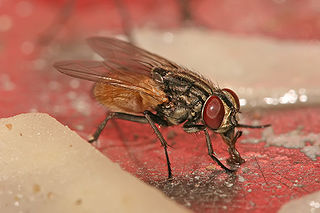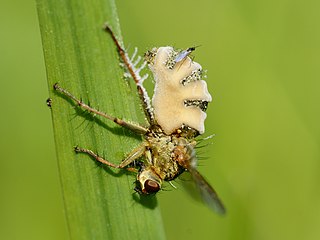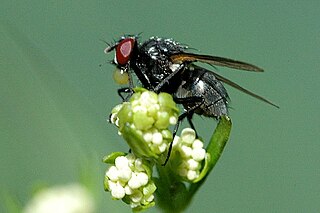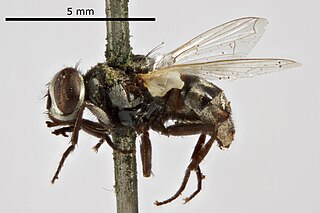
Muscidae are a family of flies found in the superfamily Muscoidea.

Eristalis is a large genus of hoverflies, family Syrphidae, in the order Diptera. Several species are known as drone flies because they bear a resemblance to honeybee drones.

Stomoxys calcitrans is commonly called the stable fly, barn fly, biting house fly, dog fly, or power mower fly. Unlike most members of the family Muscidae, Stomoxys calcitrans and others of its genus suck blood from mammals. Now found worldwide, the species is considered to be of Eurasian origin.

Haematobia irritans, the horn fly, is a small fly. It was first described by Carl Linnaeus in his 1758 10th edition of Systema Naturae. It is of the genus Haematobia which is the European genus of bloodsucking flies. Haematobia irritans is a native of Europe but has been introduced to North America and is considered a potentially dangerous livestock pest.

Musca is a genus of flies. It includes Musca domestica, as well as Musca autumnalis. It is part of the family Muscidae.

Fannia is a very large genus of approximately 288 species of flies. The genus was originally described by the French entomologist Jean-Baptiste Robineau-Desvoidy in 1830. A number of species were formerly placed in the genus Musca.

The housefly is a fly of the suborder Cyclorrhapha. It possibly originated in the Middle East, and spread around the world as a commensal of humans. It is the most common fly species found in houses. Adults are gray to black, with four dark, longitudinal lines on the thorax, slightly hairy bodies, and a single pair of membranous wings. They have red eyes, set farther apart in the slightly larger female.

Entomophthora muscae is a species of pathogenic fungus in the order Entomophthorales which causes a fatal disease in flies. It can cause epizootic outbreaks of disease in houseflies and has been investigated as a potential biological control agent.

Hydrotaea is a genus of insects in the housefly family, Muscidae. They occur in most regions of the world but are more populous in warmer climates. They are often found on feces in summer months, and are therefore generally found in close proximity to livestock. Among the 130 known species in this genus, one of the most commonly recognized is the dump fly.

Musca vetustissima, commonly known as the Australian bush fly, is a species of fly found in Australia. It is the specific fly that has given rise to the expression "Aussie salute".

Morellia is a very large genus from the fly family Muscidae. Morellia are plumpish black flies, largely lacking eye hairs - sparse at most. they have a white dusting on the parafacialia and the scutum has 4 distinct longitudinal stripes.
Nesolynx is a genus of hymenopteran insects of the family Eulophidae.

Muscina stabulans, commonly known as the false stable fly, is a fly from the family Muscidae.

Musca albina is a widespread Old World species of fly, known from the dry areas of the Afrotropical realm, North Africa and the Middle East, Central Asia, India and Sri Lanka. It is a sun-loving species, and adults have been found clustering around domestic animals to feed on sweat and other secretions and on their feces. The Namibian population at least is clearly kleptoparasitic and very specific in its oviposition behaviour, laying eggs only in dung balls being interred by one out of several co-occurring dung-rolling scarab beetle species.
Macrocheles muscaedomesticae is a species of mite in the family Macrochelidae. It has a cosmopolitan distribution.
Hytrosaviridae is a family of double-stranded DNA viruses that infect insects. The name is derived from Hytrosa, sigla from the Greek Hypertrophia for 'hypertrophy' and 'sialoadenitis' for 'salivary gland inflammation.'

Many species of flies of the two-winged type, Order Diptera, such as mosquitoes, horse-flies, blow-flies and warble-flies, cause direct parasitic disease to domestic animals, and transmit organisms that cause diseases. These infestations and infections cause distress to companion animals, and in livestock industry the financial costs of these diseases are high. These problems occur wherever domestic animals are reared. This article provides an overview of parasitic flies from a veterinary perspective, with emphasis on the disease-causing relationships between these flies and their host animals. The article is organized following the taxonomic hierarchy of these flies in the phylum Arthropoda, order Insecta. Families and genera of dipteran flies are emphasized rather than many individual species. Disease caused by the feeding activity of the flies is described here under parasitic disease. Disease caused by small pathogenic organisms that pass from the flies to domestic animals is described here under transmitted organisms; prominent examples are provided from the many species.
Hydrotaea floccosa is a species of house flies, etc. in the family Muscidae. It is found in Europe.
Hydrotaea houghi is a species of house flies, etc. in the family Muscidae from North America.
Sepsis thoracica, more commonly known as the black scavenger fly, a species of fly from the genus Sepsis and the family Sepsidae. It was discovered by Robineau-Desvoidy in 1830. It resembles a small flying ant. The fly is most commonly found inhabiting cow dung.













